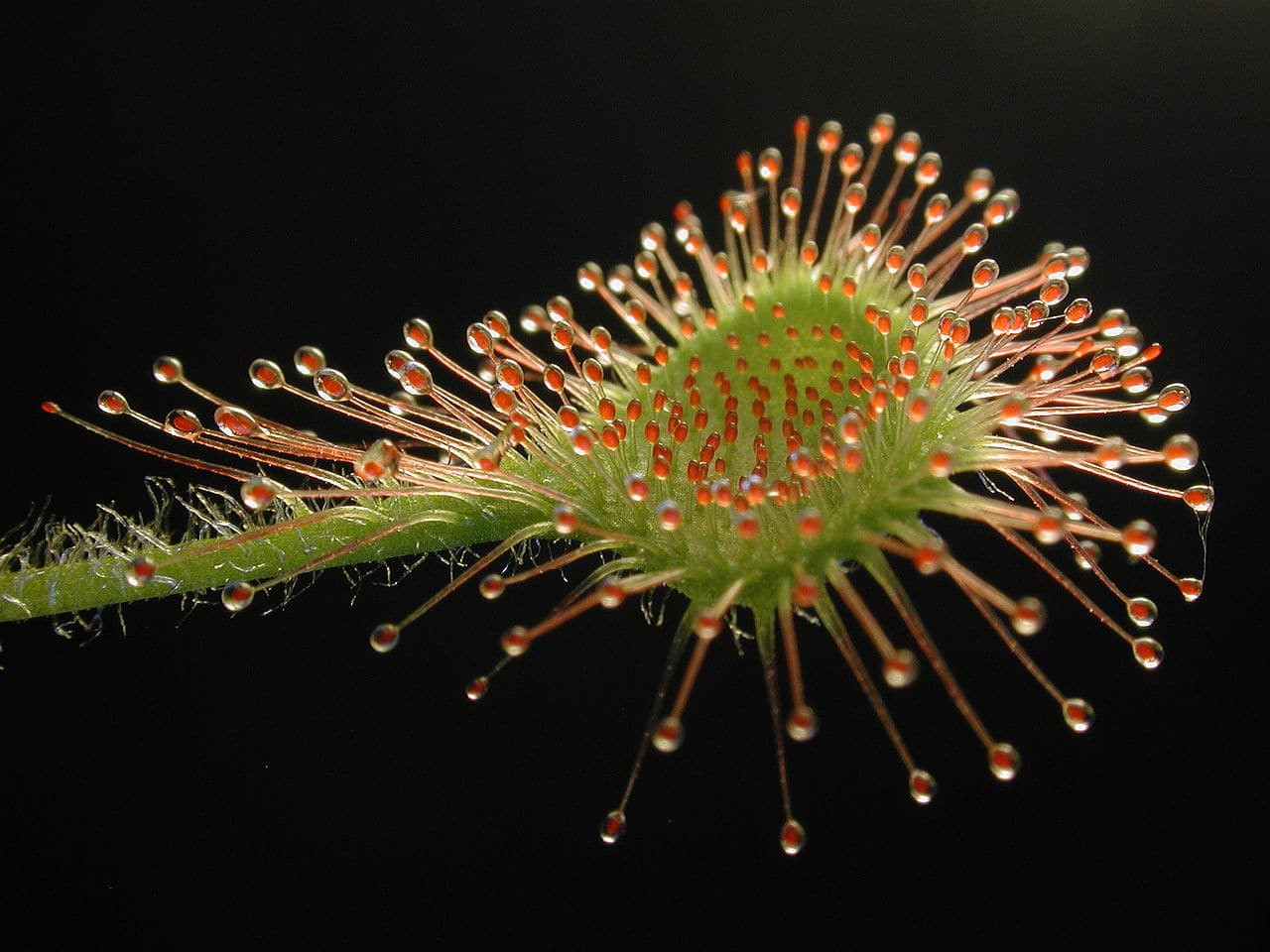
Image - Wikimedia / Petr Dlouhý
There are several types of plants that obtain their nutrients by feeding on the animals they trap, but undoubtedly some of the best known are those of the genus Drosera. They, like the Dionaea, have turned their leaves into traps, but not in the form of toothed mouths, but covering them with hairs that are very sensitive to the touch at the end of which they have mucilage, a liquid and sticky substance that prevents prey from escaping.
Their maintenance involves growing them in plastic pots with a mixture of equal parts unfertilized peat moss and perlite, watering them immediately so that they do not dry out with rain or distilled water, and keeping them in semi-shade so that the sun do not burn them. So if you dare to start or expand your collection, take a look at the 10 types of sunshades that we recommend.
sundew adelae

La sundew adelae It is a plant native to Australia where it lives on the banks of rivers. Grows forming rosettes of leaves up to 30 centimeters, and its leaves are long, lanceolate, and green. It produces dull yellow or bright red flowers.
Suitable for growing in a terrarium, or outdoors in tropical climates.
Sundew aliciae

Image - Wikimedia / H. Zell
La Sundew aliciae it is a carnivorous plant native to South Africa. It grows forming compact rosettes of about 5 centimeters in diameter.. The leaves are very small, green with reddish tentacles. Its flowers are pink, and sprout from a stem of about 30 centimeters.
It is one of the most common species, as it is able to withstand weak frosts down to -2ºC.
Sundew anglica

Image - Flickr / David Eickhoff
La Sundew anglica It is a plant native to the temperate and subtropical regions of the Northern Hemisphere. Form vertical rosettes, without stems, with linear-spatulate leaves very covered by glands with mucilage. Each leaf measures between 3 and 9 centimeters, and they are green, except for the stem that is reddish.
It supports well frosts down to -4ºC, but hibernates in cool climates.
Sundew binata

Image - Wikimedia / Noah Elhardt
La Sundew binata is a species native to Australia and New Zealand that reaches a height of 30-40 centimeters. Its rosettes are vertical, formed by reddish leaves.
It is one of the largest of the genre, and also withstands the cold. Although yes, frost can damage it.
Sundew capensis

Image - Wikimedia / Michal Rubeš
La Sundew capensis It is a native plant of the Cape, in Africa. Reaches a height of 30 centimeters, producing 6,5 cm linear leaves forming a rosette. The flowers sprout from flower stalks or scales about 30 centimeters long, and are pink in color.
There are many varieties, such as:
- Albino or Alba: its leaves are white.
- Red: with red leaves.
- Wide Leaf: with wider leaves.
In cultivation it is very interesting, since it tolerates weak frosts of up to -2ºC as long as they are punctual.
sundew madagascariensis

Image - Wikimedia / Noah Elhardt
La sundew madagascariensis is a carnivore native to Africa that reaches a height of 25 centimeters. It produces a climbing stem, from which green laminar and spatulate leaves emerge, with a size of 10-15mm long by 7mm wide. The flowers are a nice pink color.
Ideal for growing in a terrarium, or outdoors if the climate is without frost.
Drosera regal

Image - Wikimedia / Rosťa Kracík
La Drosera regal it is an endemic species to a single valley in South Africa. Forms rosettes of large leaves, up to 70 centimeters in long, covered by tentacles capable of trapping insects such as moths or beetles. The flowers it produces are pink.
It is the largest of all the Droseras, but also the most threatened. It does not resist frost.
Sundew rotundifolia

Image - Wikimedia / Ebaki
La Sundew rotundifolia It is a plant known as sundew or round-leaved sundew native to the circumboreal region. It is found in northern Europe, much of Siberia, northern North America, Korea, Japan, and New Guinea. Its leaves grow to form basal rosettes about 5 to 25 centimeters high., and produces white or pink flowers.
It is the most suitable species for beginners, as it withstands the cold and frost. But you have to know that it hibernates.
Sundew nitidula

Image - Wikimedia / Denis Barthel
La Sundew nitidula is a plant native to Australia that grows in a flat and very compact rosette of leaves, composed of horizontal leaves of about 1,5 centimeters in diameter. It produces flowers that sprout from stems or scales 2,5 centimeters long, and are whitish in color.
Being so small, it is interesting to use it to create compositions with other species of the genus. Of course, it does not resist temperatures below zero.
Sundew spatulata

Image - Wikimedia / Jan Wieneke
La Sundew spatulata, known as spoon sundew, is a carnivorous plant native to Tasmania, Australia, and New Zealand, but is also found in Japan, China, or Hong Kong. Its leaves form almost flat rosettes, very compact, about 5-6 centimeters in diameter, and can be green, yellowish-green or reddish depending on the cultivar. The flowers are white or pink, and are about 6 millimeters long.
It resists weak and occasional frosts of up to -2ºC.
Which of these types of sundew did you like the most?